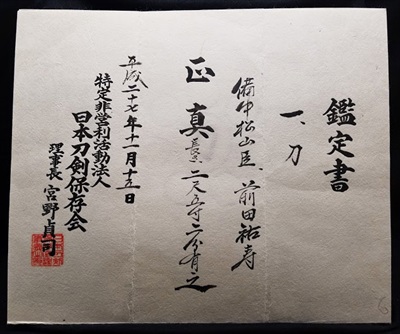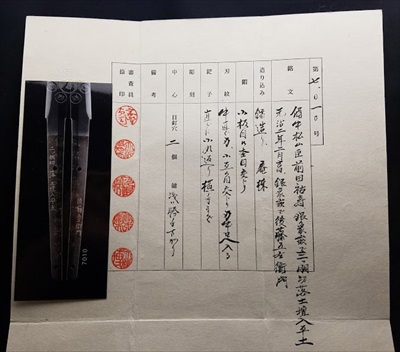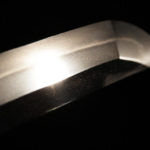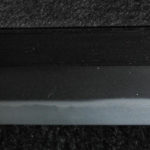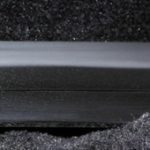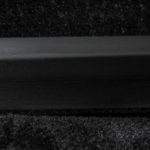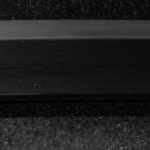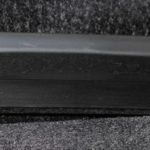Gallery Page (Display Only)
Description
A Suketoshi 76+ cm ~ 30″ KATANA
with rare 3 body ginzogan (silver inlay) cutting test
Owned by & made by Samurai! Circa 1865 A.D.
NTHK-NPO Certificate
Saya-gaki by Dr Sato (Kanzan)
Swordsmith: Maeda Suketoshi (given name: Maeda Tetsujir? (?????)) “Tetsujir? was namely of samurai rank and a retainer of the Matsuyama fief (???) of Bitch? province…” Extensive information is provided about Tetsujir? and the sword further below.
Type: Katana
Shape: shinogi-zukuri , iori-mune
Approx. Measurements- Nagasa (cutting edge length): 76.3 cm ~ 30″ Sori (curvature): 1.2 cm Motohaba (width): 3.2 cm ~ 1.26″
Kitae : dense ko-itame mixed with mokume
Hamon: chû-suguha mixed with ko-gunome and ashi
Boshi: sugu with a ko-maru-kaeri that runs back to about the height of the yokote
Nakago: suriage , 2 mekugi-ana , yasurime (?): shallow katte-sagari
Signature: Bitchû Matsuyama-shin Maeda Suketoshi (?????????), Genji ninen nigatsu kichijitsu (????????, “on a lucky day of the second month Genji two [1865]”)
Cutting test: Mitsu-dô kiri-otoshi dotan hirado-iri (??????????, “cut through three bodies and into the earthen mound below”) Gotô Gozaemon (??????) [the sword tester]
Certificate: NTHK-NPO Kanteisho( a sword designated as Important by the Society for the Preservation of the Japanese Sword )
Sayagaki: Bitchû Matsuyama Suketoshi, Genji ninen Sukenaga monjin ni, nagasa 2 shaku 5 sun 2 bu kore ari, Shôwa hinoe-umadoshi shotô no hi, Kanzan shirusu + kaô, Bitchû Matsuyama Suketoshi, [dated] Genji two (1865), student of [Yokoyama] Sukenaga, Blade length ~ 76.3 cm, A day in the tenth month of the year of the horse of the Shôwa era (1966), Written by Kanzan + kaô
Condition: Kissaki (Omote) has small ware near cutting edge
Included:Shirasaya, carry bags
kantei-sho (???) – Certificate
katana ( ? )
Bitchû Matsuyama-shin, Maeda Suketoshi ( ?????????? )
shôshin ( ?? ) – Authentic
nagasa 2 shaku 5 sun 2 bu kore ari ( ?????????? ) – Blade length ~76.3 cm
Heisei 27 nen 11 gatsu 15 nichi ( ???????????? ) – November 15 th 2015
Non Profit Organization ( ????????? )
Nihon Tôken Hozon Kai ( ??????? ) – NTHK
Board Chairman ( ??? ): Miyano Teiji ( ???? )
No 7,010
meibun ( ?? ) – Signature: Bitchû Matsuyama-shin Maeda Suketoshi ( ????????? )
Genji ninen nigatsu kichijitsu ( ???????? , “on a lucky day of the
second month Genji two [1865]”)
ginzôgan-mei : Mitsu-dô kiri-otoshi dotan hirado-iri ( ?????????? , “cut
through three bodies and into the earthen mound below”)
Gotô Gozaemon ( ?????? ) [the sword tester]
tsukurikomi ( ???? ) – Shape: shinogi-zukuri , iori-mune
kitae ( ? ) – Forging: dense ko-itame mixed with mokume
hamon ( ?? ) – Hardening: chû-suguha mixed with ko-gunome and ashi
bôshi ( ?? ) – Hardening in tip: sugu with a ko-maru-kaeri that runs back to about the height of the yokote
chôkoku ( ?? ) – Engravings:
nakago ( ?? ) – Tang: mekugi-ana ( ??? ) 2, yasurime ( ? ): shallow katte-sagari
bikô ( ?? ) – Remarks:
shinsa’in natsu’in ( ????? ): Seals of Judges: 5 seals
Sayagaki
translation:
??????
?????????
?????????
????????
???
Bitchû Matsuyama Suketoshi
Genji ninen Sukenaga monjin ni
nagasa 2 shaku 5 sun 2 bu kore ari
Shôwa hinoe-umadoshi shotô no hi
Kanzan shirusu + kaô
Bitchû Matsuyama Suketoshi
[dated] Genji two (1865), student of [Yokoyama] Sukenaga
Blade length ~ 76.3 cm
A day in the tenth month of the year of the horse of the Shôwa era (1966)
Written by Kanzan + kaô
“We neither know his date of birth nor his year of death but his real name is recorded, which was Maeda Tetsujir ? ( ????? ). We also know that his career did not start as that of a swordsmith. Tetsujir ? was namely of samurai rank and a retainer of the Matsuyama fief ( ??? ) of Bitch ? province and to understand the possible reasons for him changing his profession, we must begin with a little background information.
Right with its establishment, the Tokugawa bakufu imposed huge expenditures on each fief to basically ensure that no local ruler was economically able to overthrow the shogunal government. The new feudal system worked fine for the first century but the first problems began to appear on the horizon by the end of the 17 th century. One problem was that the coin reserves of the bakufu were running short because the major gold and silver mines were exhausted. Added to that, there was a short period of abundance during the Genroku era ( ?? , 1688-1704) caused by unusually high rice prices, and steady prices for consumer goods. This was the administrative outcome of the preceding periods, and it left the daimy? with a new taste for the finer things of life, but with the same income. As a result, the government debased gold coinage to increase the amount of money in circulation and pushed rice production, which resulted in dropping rice prices and in an inflation. In addition, Japan was facing several severe natural disasters and famines in the early 19 th century, poor financial policies on part of the bakufu , and an agricultural intensification of land that had reached its fullest possible extent. The shogunate tried to react but all the reforms and acute measures taken, such as reversion of samurai loans were of no avail. Thus it is said that by the beginning of the Tenp ? era ( ?? , 1830-1844), Japan’s ruling class was bankrupt.
Now fiefs tried to counter this, with varying success and depending on how rigid the austerity measures were, and the Matsuyama fief was of course no exception. We know cases where samurai were encouraged to go into weaving business and thus it is by no means odd for Maeda Tetsujir ? to engage in sword forging, a very honorable and so to speak appropriate thing to do for a warrior anyway. In other words, everything that generated any source of income for a fief was highly welcomed, and Matsuyama, located within the mountainous Ch ? goku region, was with an annual income of 50,000 koku one of the smaller fiefs. Therefore, it is possible that Tetsujir ? ’s change to the craft of sword forging is directly connected to this context, although it is of course also conceivable that he studied sword forging out of pure interest and on his own account.
Records suggest that Tetsujir ? received his initial training from Hamabe Toshizane ( ???? , 1777-1846), the second master of the renowned Hamabe School of Inaba province (present-day Tottori Prefecture). Hamabe Toshizane worked both in Inaba and in Edo and it is unclear of Tetsujir ? had proceeded to Inaba, which was located on the north coast of the Ch ? goku region and about 60 miles from Matsuyama, or if he had trained with the Hamabe master in the course of sankin-k?tai trips to the capital. We also know that Tetsujir ? was trained by a Bizen master and the Osafune sword center was only about 28 miles as the crow flies from Matsuyama. It is likely that his master was Yokoyama Sukenaga ( ???? ), the then dominating Osafune smith who died in Kaei four ( ?? , 1853) at the age of 57.
Consulting the meikan records, we learn that Tetsujir ? had changed his name several times but it is difficult to reconstruct the exact chronology of his name changes, mostly due to the fact that his body of work is limited, dated blades in particular. The earliest dated blade, which is from the first year of Kaei ( ?? , 1848), is signed with Toshizane ( ?? ). The meikan records list him also with the names Toshimasa ( ?? ) and Toshiyoshi ( ?? ) and say in the entry to Toshiyoshi that “he changed his name later to Toshizane.” The Toshiyoshi entry dates him into the K ? ka era ( ?? , 1844-1848) whereas the Toshizane entry says Ansei ( ?? , 1854-1860), what would match from a chronological point of view, and also from the point of view that it is by this name (Toshiyoshi) he is seen as student of Hamane Toshizane. So it seems that Toshiyoshi was his initial name as a swordsmith and that he changed it later subsequently to Toshimasa and Toshizane, or vice versa. And with completing his studies with Osafune Sukenaga, he received from this master the character for Suke , which he obviously combined with his former masters’ character of Toshi to form the smith name Suketoshi ( ?? ) (which he signed with the old variant of the character for toshi , ? ). The earliest dated blade under that name that I was able to locate is from Kaei seven ( ?? , 1854) what means that all the aforementioned name changes, i.e. from Toshiyoshi over Toshimasa and Toshizane to Suketoshi took place most likely within a period of six years. As for known date signatures in general, these are Kaei one ( ?? , 1848) for Toshizane, and Kaei seven ( ?? , 1854), Bunky ? three ( ?? , 1863), Genji one ( ?? , 1864), and Genji 2 ( ?? , 1865) for Suketoshi. Interesting is that the earliest dated blade from 1848 is interpreted in the Bizen tradition but signed with his “Hamabe name” Toshizane.
As mentioned, Toshizane died in 1846 and Sukenaga in 1853. Assuming that his initial training lasted for about five years, we can place Tetsujir ? ’s apprenticeship under master Toshizane at the latest somewhere between the late 1830s and the early 1840s. When we now further assume that he was a young man at that time, or even a teenager, we can speculate that he was born in the mid to late 1820s.
Now to his signatures. He mostly signed with a reference to his fief or to him being a retainer ( shin , ? ) of the Matsuyama fief of Bitch ? province respectively. Thus we find wordings like “Bitch ? Matsuyama-j ? ” ( ????? ), “Bitch ? Matsuyama-shin” ( ????? ), and “Biy ? Matsuyama-shin” ( ????? ) ( Biy? is another name for Bitch ? province). Apart from that, he often also added his family name Maeda and another interesting point with Tetsujir ? is that he bore, and signed with, the clan name Sugawara ( ?? ). There was namely an ? saka-based swordsmith, Sukekane ( ?? ), who died in Kansei ten ( ?? , 1798), who bore the real name Maeda Masanoj? ( ????? ) and who signed with the clan name Sugawara too. Sukekane studied, amongst others, with the famous master Ozaki Suketaka ( ???? ) and focused on the production of yari and j?monji-yari . It remains to be seen if the identical family and clan names of Masanoj ? and Tetsujir ? are a coincidence but if not, it is possible that Tetsujir ? was a descendant, maybe even the grandson of Masanoj ? and that his family had moved from ? saka to Bitch ? at some point in time. And when the fiefs were later looking for additional sources of income, Tetsujir ? ’s back-ground of coming from a family of swordsmiths might have been “reactivated” and it was ordered that he should learn from the masters Toshizane and Sukenaga to support Tsuyama as a samurai craftsman. Incidentally, the smith name Toshiyoshi ( ?? ) means literally (with its Sino-Japanese reading juga ) “congratulations for a long life,” congratulations that are expressed in particular at someone’s 61 st , 77 th , and 88 th birthday. Just as blades with auspicious connotations of smith names like Jumy ? ( ?? ) or Nobunaga ( ?? ), both meaning “longevity,” were often given as gifts, it is quite conceivable that the name choice of Toshiyoshi was a deliberate one, maybe stimulated by the aforementioned background of the need of making a profit for the fief, focusing so on blades that could be ordered as gifts. Be that as it may, we know from a signed blade that Tetsujir ? used the g? Tetsury ? shi ( ??? , lit. “Son of the Iron/Steel Dragon”), probably aiming at the Hamano g? Minry ? shi ( ??? ) of his initial master Toshizane.
With this we come to his workmanship. All blades that I was able to locate are forged in the Bizen tradition and the early blade from 1848 that is signed with Toshizane is described as “bearing a resemblance and comparing favorably with works of master Sukenaga,” showing a hamon that starts with Fujimi-Saigy? at the base and that turns into a mix of kobushi-ch?ji and j?ka-ch?ji . Both the Fujimi-Saigy? feature and a kobushigata-ch?ji are also known to have been applied by Hamabe Toshizane, although Osafune Sukenaga worked in kobushigata-ch?ji too. Thus we might see here a mix of both styles, or the Yokoyama style being combined with a feature from the Hamane School. This blade and its tachi-koshirae (see picture below) were handed down as having been worn by Itakura Katsukiyo ( ???? , 1823-1889) who was the seventh daimy? of the Bitch ? Matsuyama fief. The sword is today designated as a cultural property of Takahashi City. It is signed “Bitch ? Matsuyama-shin Maeda Toshizane” ( ????????? ) and dated “Kaei gannen gogatsu hi” ( ??????? , “a day in the fifth month Kaei one [1848]”).

Got ? Gozaemon was a retainer of the Niimi fief ( ??? ) of Bitch? province that bordered Matsuyama to the northwest. Gozaemon was also a tameshigiri student at the famous Yamada Asaemon ( ?????? ) family of sword testers and served them later as a clerk. Incidentally, Gozaemon’s second son Yoshitoshi ( ?? , 1813-1884) became later as adopted son-in-law the 7 th head of the Yamada family. As an interesting side note, there exists a blade by the Osafune swordsmith Yokoyama Sukekane ( ???? ) which bears a cutting test inscription by Got ? Gozaemon (see picture 10). Thus it is possible that Gozaemon tested swords for the Yokoyama family on a regular basis and that the test with the aforementioned blade from Genji two goes back to this connection. However, it has to be pointed out that the cutting test of the Suketoshi blade is inlayed in silver ( ginz?gan ) whereas that of the Sukekane blade is inlayed in gold ( kinz?gan ). The choice of silver might go back to economical considerations by the client as the sword test itself was not cheap either. Thus it was maybe tried to cut down costs at this point but not with the blade, its mountings, and the-to be performed cutting test. Also noteworthy is the fact that the active period of Got ? Gozaemon is usually dated around Ky ? wa ( ?? , 1801-1804) and the cutting test of the Sukekane blade was performed in Bunsei two ( ?? , 1819). This means that the Suketoshi cutting test from Genji two ( ?? , 1865) must have been performed by Gozaemon at a very advanced age. The blade in question is signed “Bitch ? Matsuyama-shin Maeda Suketoshi” ( ????????? ) and dated “Genji ninen nigatsu kichi-jitsu” ( ???????? , “on a lucky day of the second month Genji two [1865]”) and the cutting test reads: “Futatsu-d ? kiri-otoshi dotan hirado-iri” ( ?????????? , “cut through three bodies and into the earthen mound below”) and Got ? Gozaemon ( ?????? )
The choice of silver might go back to economical considerations by the client as the sword test itself was not cheap either. Thus it was maybe tried to cut down costs at this point but not with the blade, its mountings, and the-to be performed cutting test.
In terms of rarity it is estimated that less than 5% of all blades currently existing were used for cutting test purposes on human corpses. Cutting tests were basically subdivided into hitotsu-d? ( ??? ) and kasane-d? ( ??? ), the former category applying to all cuts carried out on a single body and the latter to those on stacked bodies or on bodies arranged next to each other. To state now that a sword has a superior or better-than-average cutting ability, one either uses a demanding hitotsu-d? or a kasane-d? setup with as much as possible bodies. Therefore we find relative many two body cuts as piling up two torsos was, so to speak, the “entry” into impressive sounding cutting tests. When we use the data of all blades that passed the NBTHK j?y? and tokubetsu-j?y? criteria, we arrive at the following statistics: Of roughly 14,000 blades in total, only about 120 bear a cutting test, what equals to about 1%. Of course, this data is restricted to only the very best blades and famous heirloom swords which were hardly tested but it offers the only concrete data base to work with for the time being. Of these 120 cutting tests swords about 80 (? cut through two bodies, about 40 (? through three bodies, and only two blades are registered that cut through four bodies. However, we know blades that cut through five, six, and even up to seven bodies from outside the realm of j?y? and tokubetsu-j?y? swords (see Sesko, Tameshigiri – The History and Development of Japanese Sword Testing , p. 186ff) but these are considered as an absolute rarity.
Last but not least it should be mentioned that it is unusual to have a samurai smithing his own swords. It can be argued that this unique perspective from someone who would actually use the weapon would give a better understanding of the demands on a blade in the contest of its use in battle. With the bakumatsu era, Japan was in a difficult situation as mentioned. More and more foreigners appeared at the coasts, the fiefs were bankrupt and the bakufu was regarded as totally incompetent. Everyone felt that something was going to happen soon, most likely in combination with fightings. As it is common for such times, there was a return to old values, a general mood that swordsmiths and their clients could not ignore. With this mood, there was a certain turning away from sophisticated art swords as now more martial blades were considered to be the best to fulfill whatever might come, for example reflected via the second, so to speak “safety” mekugi-ana at the bottom of the tang on some blades of Suketoshi and his contemporaries. As for the historical context of the Genji two (1865) blade of Suketoshi that was tested by successfully cutting through three bodies, his lord Itakura Katsukiyo had just returned from the First Ch ? sh ? Expedition the previous month, the punitive military expedition led by the Tokugawa Shogunate against the Ch ? sh ? fief. And in the following, the third month of that year, it was decided for a second expedition and Katsukiyo was, as a r?j? elder, i.e. one of the highest ranks of the bakufu , again going to participate…”
The information provided on this page resting within quotes were researched & written by Markus Sesko. You can view his extensive Japanese sword & related reference catalogs for sale at lulu.com or see his website
Gallery
This Sword is not available for purchase.
If you wish to purchase a Japanese Sword please view our Nihonto for sale page or contact us directly via email or contact us at 1(608) 315-0083 any time, please include specifics of what you seek, i.e.: Katana, maker, era, price range etc.
Pictures and content may not be copied without the express permission of samuraisword.com ©





